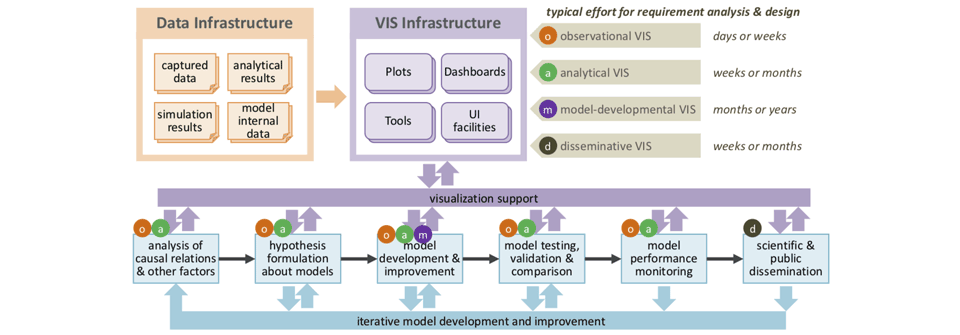Journal papers published in Epidemics and in Phil. Trans. R. Soc. A.

Two journal papers from the RAMPVIS project have been published in Elsevier’s Epidemics and in the Philosophical Transactions of the Royal Society A (Special issue on ’Technical challenges of modelling real-life epidemics and examples of overcoming these’). Bangor’s contribution in both works revolves around public engagement and disseminative visualisation for the Covid-19 pandemic.
Reference
J. Dykes, A. Abdul-Rahman, D. Archambault, B. Bach, R. Borgo, M. Chen, J. Enright, H. Fang, E. E. Firat, E. Freeman, T. Gönen, C. Harris, R. Jianu, N. W. John, S. Khan, A. Lahiff, R. S. Laramee, L. Matthews, S. Mohr, P. H. Nguyen, A. A. M. Rahat, R. Reeve, P. D. Ritsos, J. C. Roberts, A. Slingsby, B. Swallow, T. Torsney-Weir, C. Turkay, R. Turner, F. P. Vidal, Q. Wang, J. Wood, and K. Xu, “Visualization for Epidemiological Modelling: Challenges, Solutions, Reflections & Recommendations,” Philosophical Transactions of the Royal Society A (Special issue on ’Technical challenges of modelling real-life epidemics and examples of overcoming these’) , vol. 380, no. 2233, p. 20210299, Aug. 2022.
We report on an ongoing collaboration between epidemiological modellers and visualization researchers by documenting and reflecting upon knowledge constructs - a series of ideas, approaches and methods taken from existing visualization research and practice – deployed and developed to support modelling of the COVID-19 pandemic. Structured independent commentary on these efforts is synthesized through iterative reflection to develop: evidence of the effectiveness and value of visualization in this context; open problems upon which the research communities may focus; guidance for future activity of this type; and recommendations to safeguard the achievements and promote, advance, secure and prepare for future collaborations of this kind. In describing and comparing a series of related projects that were undertaken in unprecedented conditions, our hope is that this unique report, and its rich interactive supplementary materials, will guide the scientific community in embracing visualization in its observation, analysis and modelling of data as well as in disseminating findings. Equally we hope to encourage the visualization community to engage with impactful science in addressing its emerging data challenges. If we are successful, this showcase of activity may stimulate mutually beneficial engagement between communities with complementary expertise to address problems of significance in epidemiology and beyond.
[Abstract]
[Details]
[PDF]
[Preprint]
[doi:10.1098/rsta.2021.0299]
M. Chen, A. Abdul-Rahman, D. Archambault, J. Dykes, A. Slingsby, P. D. Ritsos, T. Torsney-Weir, C. Turkay, B. Bach, R. Borgo, A. Brett, H. Fang, R. Jianu, S. Khan, R. S. Laramee, P. H. Nguyen, R. Reeve, J. C. Robert, F. Vidal, Q. Wang, J. Wood, and K. Xu, “RAMPVIS: Answering the Challenges of Building Visualisation Capabilities for Large-scale Emergency Responses,” Epidemics, vol. 39, no. 100569, Jun. 2022.
The effort for combating the COVID-19 pandemic around the world has resulted in a huge amount of data, e.g., from testing, contact tracing, modelling, treatment, vaccine trials, and more. In addition to numerous challenges in epidemiology, healthcare, biosciences, and social sciences, there has been an urgent need to develop and provide visualisation and visual analytics (VIS) capacities to support emergency responses under difficult operational conditions. In this paper, we report the experience of a group of VIS volunteers who have been working in a large research and development consortium and providing VIS support to various observational, analytical, model-developmental, and disseminative tasks. In particular, we describe our approaches to the challenges that we have encountered in requirements analysis, data acquisition, visual design, software design, system development, team organisation, and resource planning. By reflecting on our experience, we propose a set of recommendations as the first step towards a methodology for developing and providing rapid VIS capacities to support emergency responses.
[Abstract]
[Details]
[PDF]
[Preprint]
[doi:10.1016/j.epidem.2022.100569]